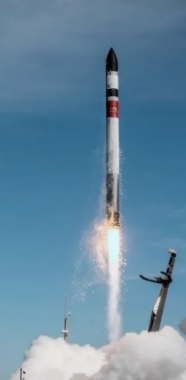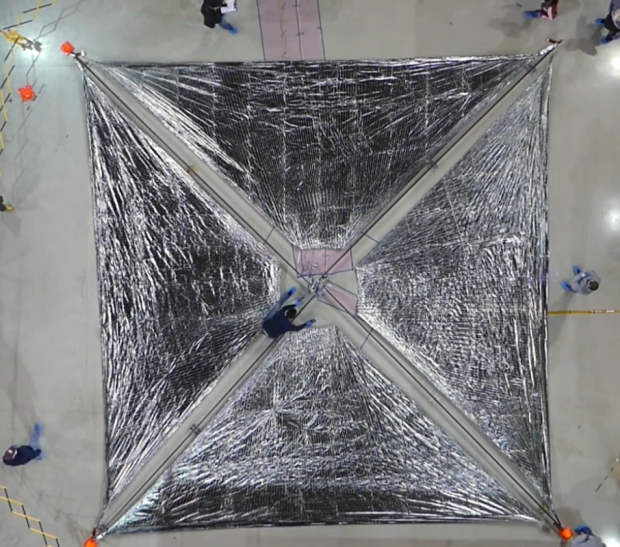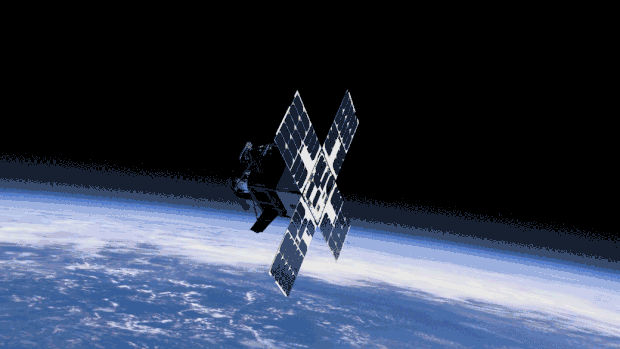
Rocket Lab, a launch service provider based in Long Beach CA, launched a rideshare payload on April 23 from its launch complex in New Zealand. I’ve been tracking that launch because aboard the Electron rocket was an experimental solar sail that NASA is developing to study boom deployment. This is important stuff, because the lightweight materials we need to maximize payload and performance are evolving, and so are boom deployment methods. Hence the Advanced Composite Solar Sail System (ACS3), created to test composites and demonstrate new deployment methods.
The thing about sails is that they are extremely scalable. In fact, it’s remarkable how many different sizes and shapes of sails we’ve discussed in these pages, ranging from Jordin Kare’s ‘nanosails’ to the small sails envisioned by Breakthrough Starshot that are just a couple of meters to the side, and on up to the behemoth imaginings of Robert Forward, designed to take a massive starship with human crew to Barnard’s Star and other targets. Sail strategies thus move from using them as propulsive projectiles (Kare) to full-blown interstellar photon-catchers for high-speed star travel.
With ACS3, we’re at the lower end of the size spectrum and digging into such fundamental matters as composite materials and boom deployment engineering. Entertainingly, the Electron launch vehicle was named ‘Beginning of the Swarm,’ doubtless a nod to the primary payload, which is a South Korean imaging satellite that will be complemented by 10 similar craft in coming years. But I also like to think that ‘swarms’ of small solar sails like the twelve-unit (12U) CubeSat used for ACS3, will eventually offer options not only for near-Earth but also outer system observation and exploration. But first, we have to nail down those tricky deployment issues. Keats Wilkie is ACS3 principal investigator at NASA Langley in Hampton Virginia:
“Booms have tended to be either heavy and metallic or made of lightweight composite with a bulky design – neither of which work well for today’s small spacecraft. Solar sails need very large, stable, and lightweight booms that can fold down compactly. This sail’s booms are tube-shaped and can be squashed flat and rolled like a tape measure into a small package while offering all the advantages of composite materials, like less bending and flexing during temperature changes.”

Image: On 24 April 2024, Rocket Lab launched the ACS3 & NeonSat-1 missions from Onenui Station (Mahia Peninsula), New Zealand. In this image, engineers at NASA’s Langley Research Center test deployment of the Advanced Composite Solar Sail System’s solar sail. The unfurled solar sail is approximately 30 feet (about 9 meters) on a side. Credit: NASA Ames.
ACS3 reached its final orbit a little less than two hours after liftoff, after earlier deployment of the South Korean NEONSAT-1 via a kick stage that changed orbit for the second of the deployments. The craft is now roughly 1000 kilometers up, and if everything goes well, full deployment of the composite booms spanning the diagonals of the sail will give us an 80 square meter sail as bright as Sirius in the night sky. Digital cameras onboard should provide imagery of the sail before and during deployment. No signs of sail deployment yet but the satellite is being observed at numerous sites.
Still nothing from ACS3 on 2268 MHz, but an absolute rainbow of 2k4 packets on 401.5 via 2.5-turn helical omni! Decoded as 'Light-1' frames in GNU Radio / gr-satellites + upload to SatNogs. Fun pass from 1000 Km ALT whether S-Band makes an appearance or not pic.twitter.com/LDlfjm2Gkq
— Scott Chapman (@scott23192) April 25, 2024
The polymer from which the composite booms are made is reinforced with carbon fiber and flexible enough to allow it to be rolled for compact storage. According to Alan Rhodes, lead systems engineer for the mission at NASA Ames, seven meters of deployable booms can roll up into a shape that fits into the hand. Note too that these booms are 75 percent lighter than previous metallic deployable booms and should experience far less in-space thermal distortion during flight. A new tape-spool boom extraction system is being tested which will, engineers hope, minimize the possibility of the coiled booms jamming during the deployment. We shall see.

Animation: Deployment of the ACS3 sail. Credit: NASA Ames.
We’re getting pretty good at miniaturization, as shown by the fact that the 12-unit CubeSat carrying ACS3 into orbit measures roughly 23 centimeters by 34 centimeters, which makes it about the size of the microwave oven sitting on my kitchen counter. Refining the material and structure of the booms is another step toward lower-cost missions which we can eventually hope to deploy in networked swarms. Imagine a constellation of exploratory craft to targets like the ice giants. Larger sails using these technologies may eventually fly the kind of ‘sundiver’ missions we’ve often discussed here, deploying at perihelion for maximum thrust to deep space.



Nice paper on the sail technology, with a view of the boom.
Apart from the novel boom design and material, the sail material is a very thin, low-cost, 2-micron, polyethylene naphthalate (PEN) plastic coated with aluminum.
The mission is quite short and seems similar to the Planetary Society’s Lightsail.
While a demonstration sail to test the technology, it still seems behind the much earlier JAXA IKAROS sail that had solid state means to orient the sail and manage interplanetary flight. The US has not managed either yet,
I hope this all goes well (after the failure of NEA Scout) and that larger versions with interplanetary flight capabilities are launched to show the value of solar sailing for deep space missions.
@Alex
Apart from the free use of the sun for propulsion, I like the idea that beams can be used to boost the sail acceleration/deceleration if desired/needed. This seems a very flexible means of propulsion (and not one sailing ships had).
Yes, they are slow, but they have advantages no other propulsion has. If the areal density is low enough, they can be used as statites allowing polar sitting, and as we have seen in an earlier post, be used to reach the velocities of their initial orbit on linear trajectories that can exit the solar system. Maybe not as sexy as fusion or antimatter propulsion, and certainly not as powerful (unless intense beams are used), but there seems like a lot of scope for development, especially if we can eventually create graphene sails. We have barely explored the development of different sail designs, with the “kite” design being the most used due to its simplicity.
I hope that there is a flowering of this technology once the basic techniques are worked out.
Can statites be used for spacelift?
Two cables cross in the X and by tacking towards or away, the intersection point rises and falls—perhaps with a flying windlass with its own tether reel to pick up objects or put them down.
At Cosmoquest Forum, I remember that Earth gets a 60,000 ton shove from the Sun…but I repeat myself
The effectiveness of a statite will depend on its areal density. Assume that it is a pole sitter, and that with an orientation that shows a smaller fraction of its area to the sun it is a statite, and with a maximum of 45 degrees, it will rise against Earth’s gravity. The difference in forces between the 2 orientations will determine the net force that the statite can employ to act as a skyhook. Alternatively, the orientation to maximize lift against gravity can be maintained by tethering the statite to the ground.
The lift can be achieved by lifting a old off the ground by paying out the tether, or by a similar method as suggested for a space elevator – crawling up the tether.
The statite has to have a very low areal density it it is to work as a statite before lifting any load. The load itself must use some form of force distribution across the sail. The sail designs we have don’t scale to allow very large sails, so I don’t think this is a practical method.
But referring back to the Medusa sail propulsion, what if the statite has to have nuclear explosion[s] beneath it? Could this provide the forces needed to lift payloads? The explosions would be in space (unlike the original Orion concept) [but still a violation of the Outer Space Treaty], and the payload would be lifted from the ground with just100s km of tether, rather than 40,000 from GEO with the space elevator, obviating the cable strength issue. The Medusa approach removes the areal density issue except as regarding being a statite. However, the bomb payload need not be part of the sail, with the bombs delivered from a separate vehicle, each bomb orbiting and detonating once beneath the sail.
IMO, a crazy idea, but I think a novel use of sails and propulsion as a heavy lift mechanism.
I had an idea about a back-spun asteroid bola. This would fly by Earth, deposit one load, and snag something from the water.
Rockets could be used to get a hydrofoil up to speed just to lessen strain on the tether.
You might need to “bag” the asteroid in something thicker than sails…rockwool from the body.
This is likely one big, sturdy chunk:
https://www.forbes.com/sites/jamiecartereurope/2024/04/27/earths-new-second-moon-is-as-big-as-the-statue-of-liberty-and-we-now-know-its-origin/?sh=70071d802ecb
A cable cuts a body—like Kursk—and the rotation provides artificial gravity on the tether facing sides.
Rotational velocity might be converted into translational by playing out the bola and releasing one end to send it towards a destination.
Ironic how space travel could be less Flash Gordon—and more Tarzan
An asteroid version of a rotating skyhook?
Rotating Skyhook.
I think your version of bolas would make for some scary moments as the mass coming down through the atmosphere and skimming the ocean to pick up or drop off a payload. Some potentially nasty “oops…”. ;-)
It is a way to avoid re-entry—do it over water.
Impact tsunami perhaps less a problem than thought
https://www.researchgate.net/figure/Asteroid-Tsunami-Wave-Heights_tbl1_264038273
Now imagine a single shot space-base….lathes, heavy equipment.
This would be unmanned. Rockets move it—soft landing on the Moon requires very little.
Humans reach it by rocket.
Perhaps a statite web that can catch passing objects—-pulling at ever-thicker cables to pull heavy items up a bit at a time.
Just in–
Phys.org has an article (about the research of UC Irvine’s Dimitri Fishman) entitled–
RESEARCH TEAM DISCOVERS NEW PROPERTY OF LIGHT:
“Photons can obtain substantial momentum, similar to that of electrons in solid materials.”
Silicon was mentioned.
Now, I seem to remember something about silicon solar sails having an added bounce–from Space Daily 15-20 years ago.
Anyone else remember that?
Hi Paul
Yes this is an amazing mission to follow, and the article below is worth reading.
Nasa, Rocket Lab launch solar sail from Hawke’s Bay
https://www.rnz.co.nz/news/national/515083/watch-nasa-rocket-lab-launch-solar-sail-from-hawke-s-bay
I used to go camping at Māhia during the 90s every summer, and If you had said to me then rockets would be launching from there I would have said you were dreaming! But here we are.
Cheers Edwin
It would be interesting if we could send loads of these sails out say toward where we think planet 9 hangs out.
Possible more statistical evidence of planet 9.
https://astrobiology.nasa.gov/news/caltech-researchers-find-evidence-of-a-real-ninth-planet/
Planet 9 orbits the sun within the SGL. I wonder which stars would be viewable with a telescope based on planet 9?
Or in orbit about it.
Alex, no matter where it points at the SGL the discoveries would be enormous, the first stars and even the first blackholes.
I cover a large amount of concepts in my books on light-sails. It is so nice to see that government organizations are starting to take solar sailing seriously.
Solar sailing does not need to be a low acceleration mechanism. It is plausible that concentrated and collimated sun-light could propel fairly large spacecraft to close to light-speed in a matter of days.
The idea here is that pressure deployable membranous optics in solar orbit would process the needed sunlight.
Optics for conditioning sunlight may also be electrostatically or magnetostatically deployed although the required charge may be difficult to achieve. Additionally, electrodynamically charged optics would have to contend with the solar magnetic field. I do not see these aspects at all as show stoppers but will need to be taken into account for charge deployed optics.
My brother John and I patented lots of interesting types of inflatable pressure deployed optics under the subject of multi-function inflatable solar concentrators, mostly for solar cooking and other related activities. All of our patents have expired via time limits or inability to afford the maintenance fees. Some of these optics in their basic geometry could be scaled up for use in processing sunlight.
Possibly this kind of inflatable reflector, on a very large scale, could be deployed as a solar statite for station keeping and used to drive a solar sale at high acceleration?
https://patents.google.com/patent/US6897832B2/en
As there is no air pressure in vacuum, the deformable membranes cannot be concave. It would need 2 more [non-deformable?] membranes to hold a gas to allow the inner membranes to become concave with lower pressure between them. As designed, they will only work in atmospheres.
NASA Glenn had designed similar examples using inflatables. Krafft Ehricke had used spheres with 1/2 the surface mirrored to focus sunlight for solar thermal propulsion.
IMO, a rotating Fresnel lens is a better way to go. It needs no gases, is self stabilizing, and lower mass. Deployment requires unfurling, perhaps by rotation using the usual origami methods. How easy it is to manufacture large lenses this way, idk, but it is not a novel idea, so I assume it has been looked at. But as with all such approaches for increasing light intensity, it it best used for fixed focus use, or to create an approximate parallel beam to project light to a distance without the usual 1/d^2 decrease in intensity as Forward suggested for solar sailing to the stars.
Some time ago there was a CD post on a Mars vehicle that used a reflector to focus a remote laser source onto propellant. Given how abundant volatiles are in the solar system, the availability of propellant for refuelling seems like an obvious choice to be coupled with focussed light for deep space transport. I would like to see some examples of hybrid systems, where propellant can be used for faster maneuvering (e.g. docking) while the sail is used for the main propulsion. Sunlight/lasers/microwave beams providing the energy.
Yes, components #18 at the centre of the diagrams are pressure valves – so it can only act to remove pressure from the ‘lens’ within the torus so atmospheric pressure can deform it to concave.
Wonder, if components #18 were instead anti-aligned magnets, couldn’t they put the required tension on the inner membrane to render it concave?
Advantage of a mirror over a Freznel lens might be also use the momentum reflection for statite station keeping.
Or perhaps better, opposing electrostatic charge on the top and bottom membranes rather than magnets to take the place of atmospheric pressure on creating the parabolic shape. But the design is getting more complex an it takes away from the original simplicity of the inflatable mirror.
Hi Paul
A very large Solar Sail was suggested by David Brin years ago. Attach one 70,000 km wide to the Moon. Keep the Sun shining on it and it’ll produce 70 billion newtons thrust. Over 5.5 billion years that’ll drag both outwards by at least 0.15 AU – enough to save the Earth from the Sun’s steady increase in luminosity. Probably even further out.
David must have written that one up somewhere. Do you have the reference, Adam? I’ve never actually read it.
Hi Paul
He was expounding on it to a bunch of listeners after a few drinks at UCSD back in 2013 when I first heard his discussion of it, so I’m not sure he ever wrote it up.
Probably better to convert the solar flux on the moon into power for a particle accelerator which then ejects matter out from the moon surface to move the moon earth system. Or even use mercury’s mass and solar flux position to throw a stream of matter towards earth and move it that way. Time it well and that matter could be used to reform at a different place in the solar system to make habitats.
A few hundred terrawatts of dust thrown out over a billion years should be ok to move with the lum increase. The moons dust can be highly charged by the sun allowing electrostatic accelerators which reduce complexity.
NASA’s Solar Sail Makes First Contact From Space Before Stretching Its Enormous Wings
The mission launched on April 23 to test sunlight-propelled space travel.
By Passant Rabie
Published Yesterday
Nearly a week after launching to space, a microwave-sized cubesat phoned home for the first time as it prepares to embark on its mission of sailing through low Earth orbit.
NASA’s Advanced Composite Solar Sail System (ACS3) contacted ground operators on Tuesday at 2:30 a.m. ET as it passed over the ground hub located at Santa Clara University’s Robotics Systems Lab in Santa Clara, California, the space agency announced in a blog post.
Full article here:
https://gizmodo.com/nasa-solar-sail-first-contact-from-space-1851449783
Details on the mission and satellite here:
https://www.nasa.gov/general/nasa-next-generation-solar-sail-boom-technology-ready-for-launch/
Hi Paul
Maybe someone else should write up the Earth-Moon Gravity-Tractor? I’m sure it’s been a hand-wave in various papers on long term projects. I should ask Richard Cathcart if he knows given his writeups of Stellar Engines.
Yes, why not check with Richard, Adam, and let us know what you find out. Interesting idea.